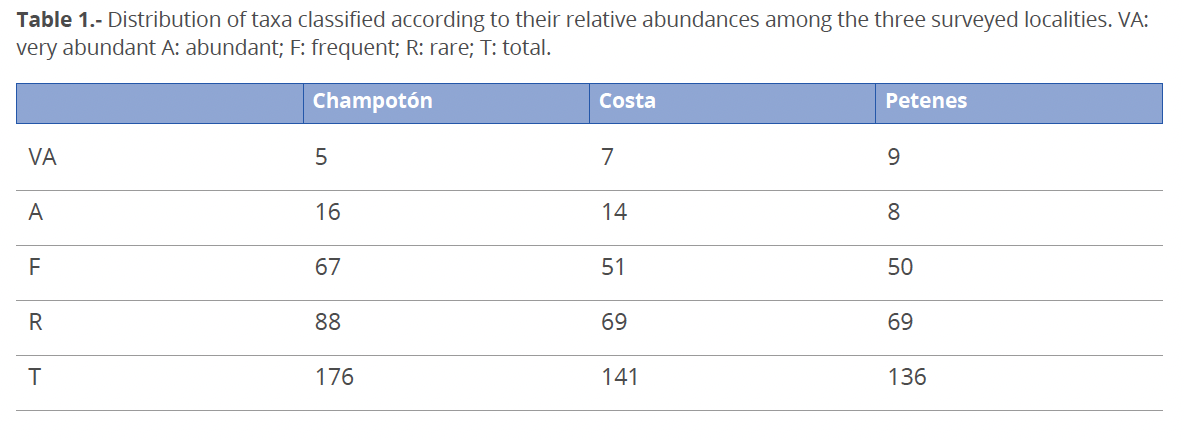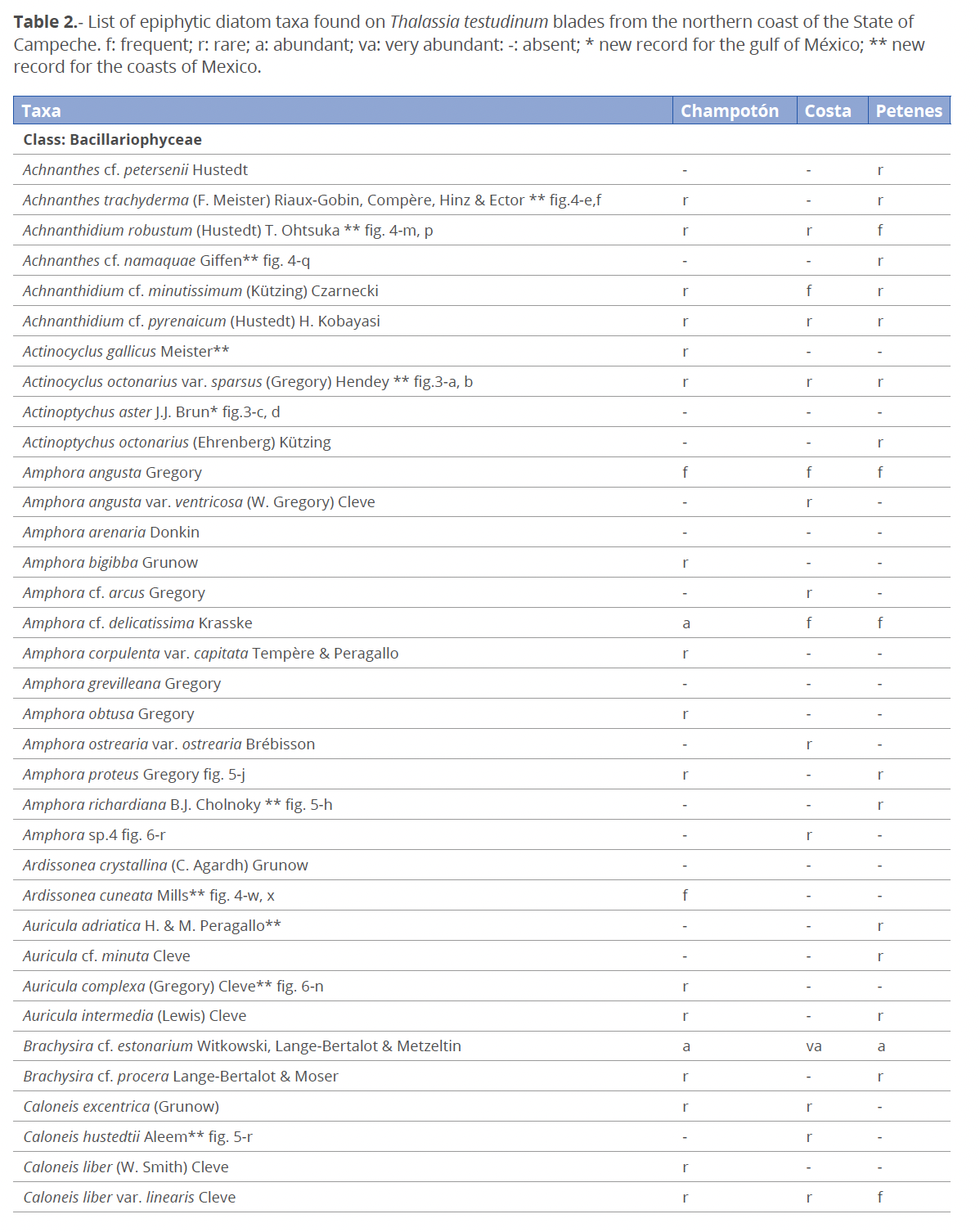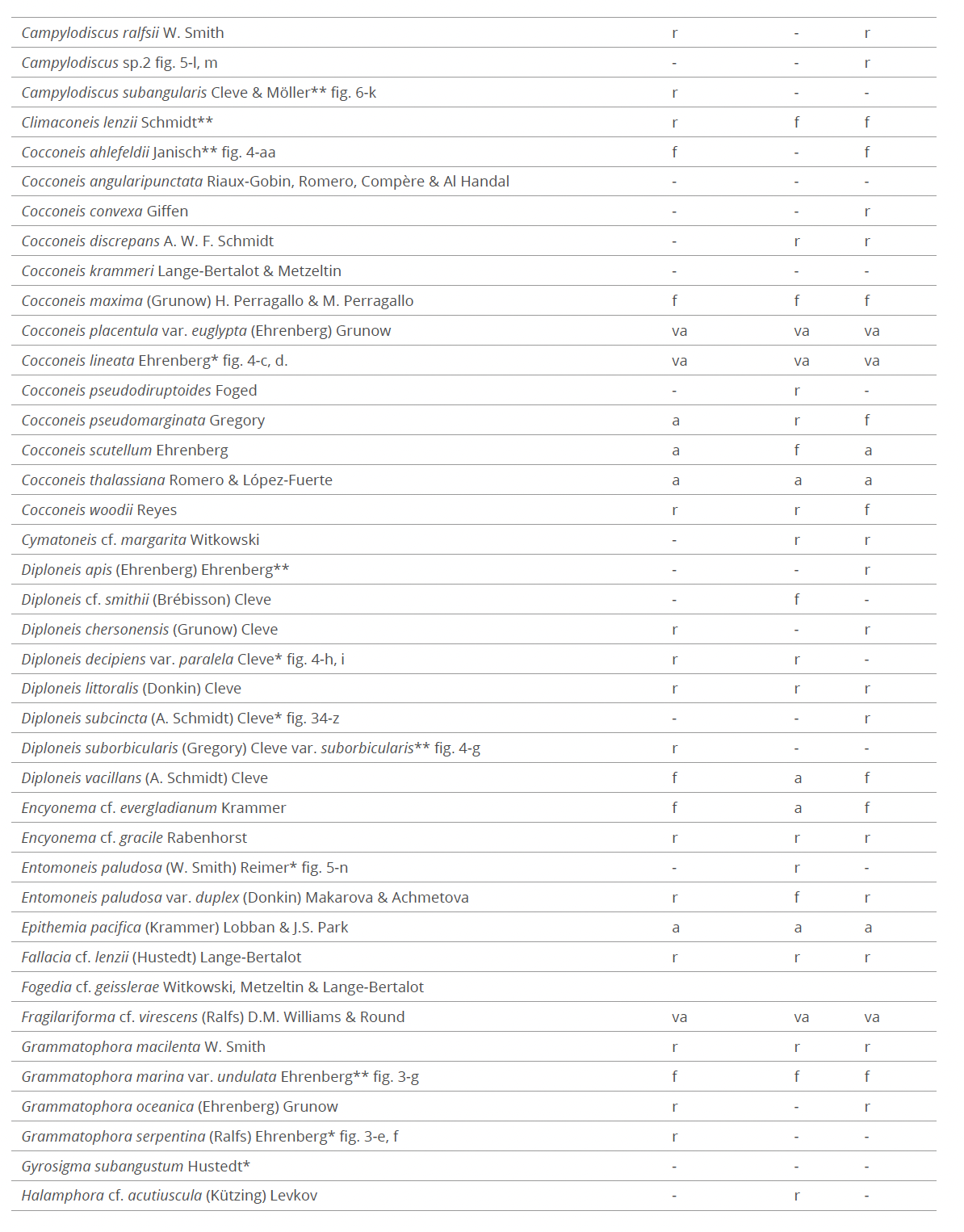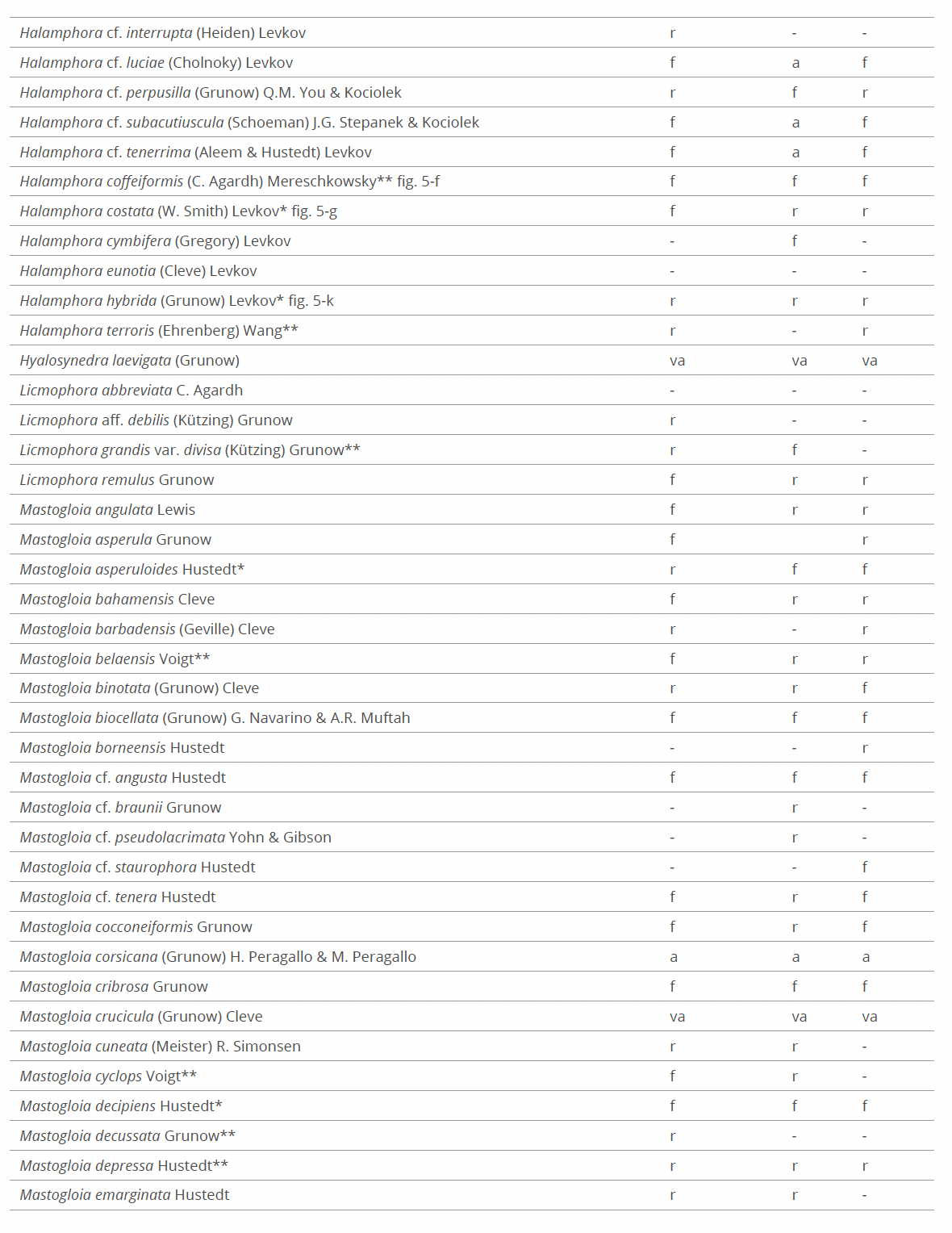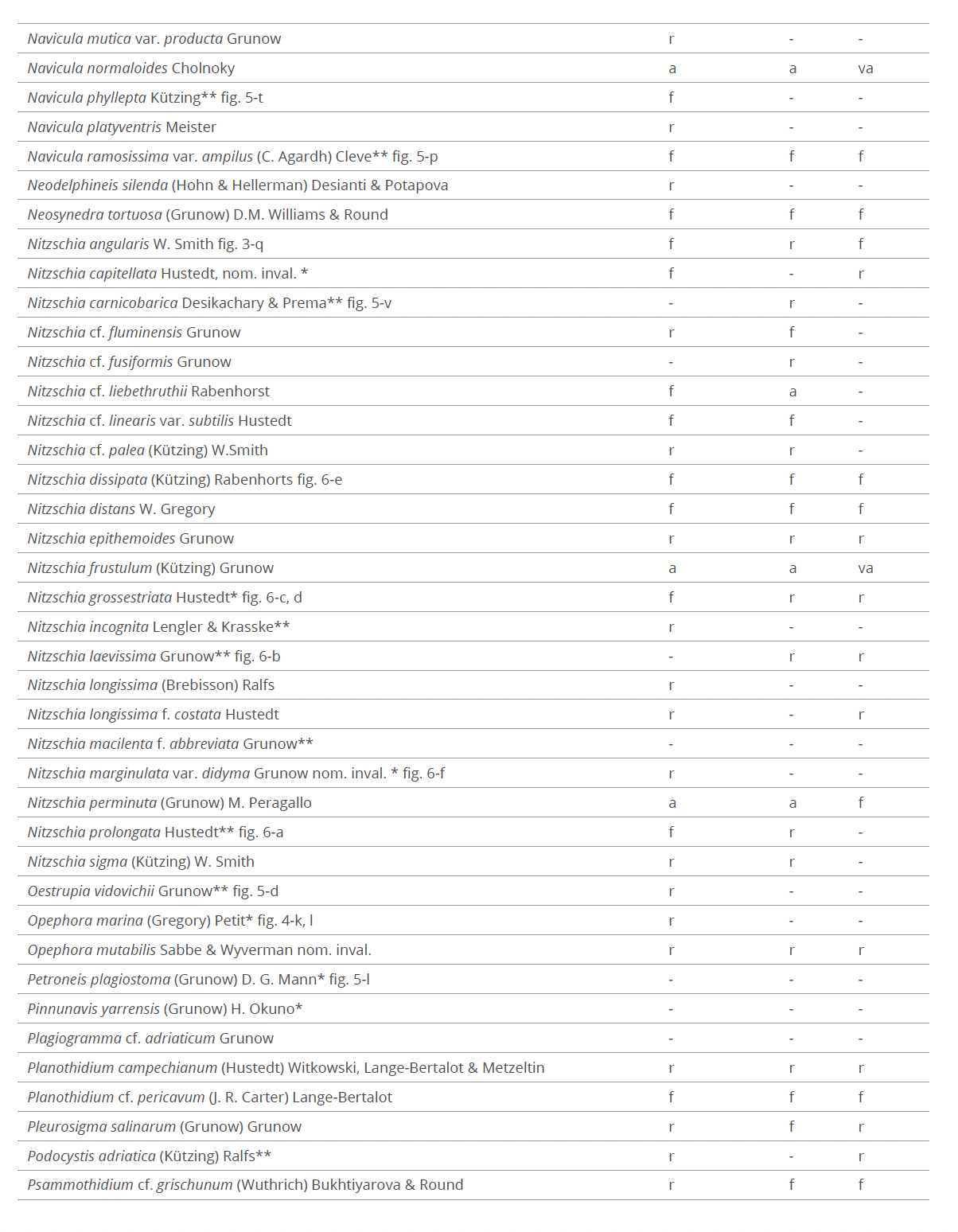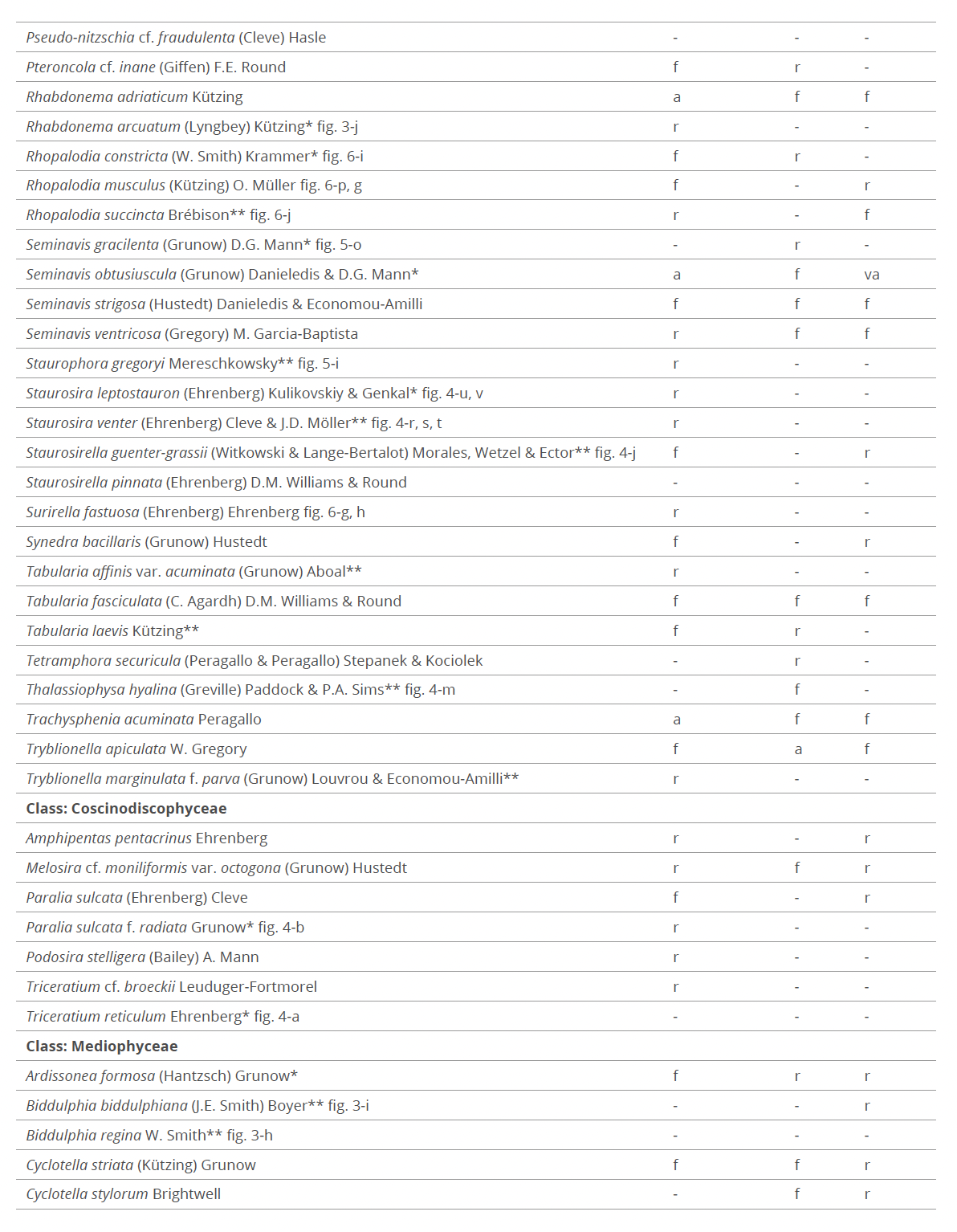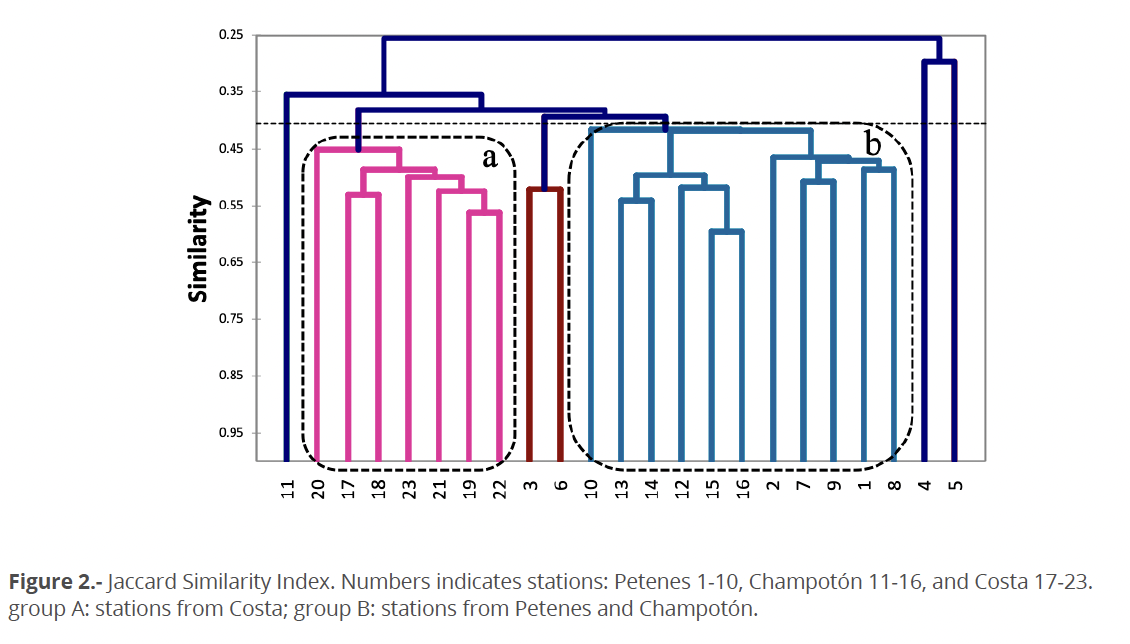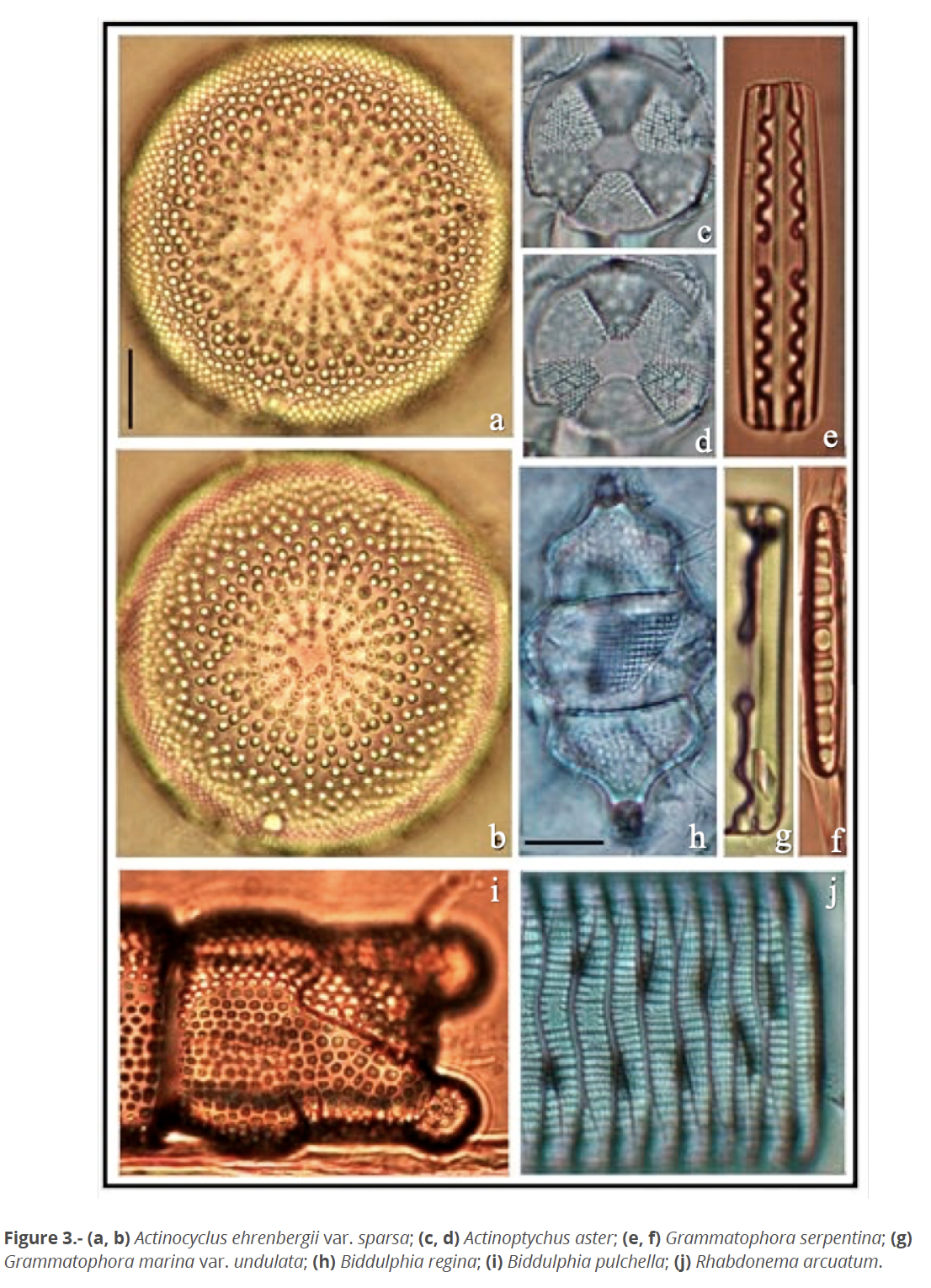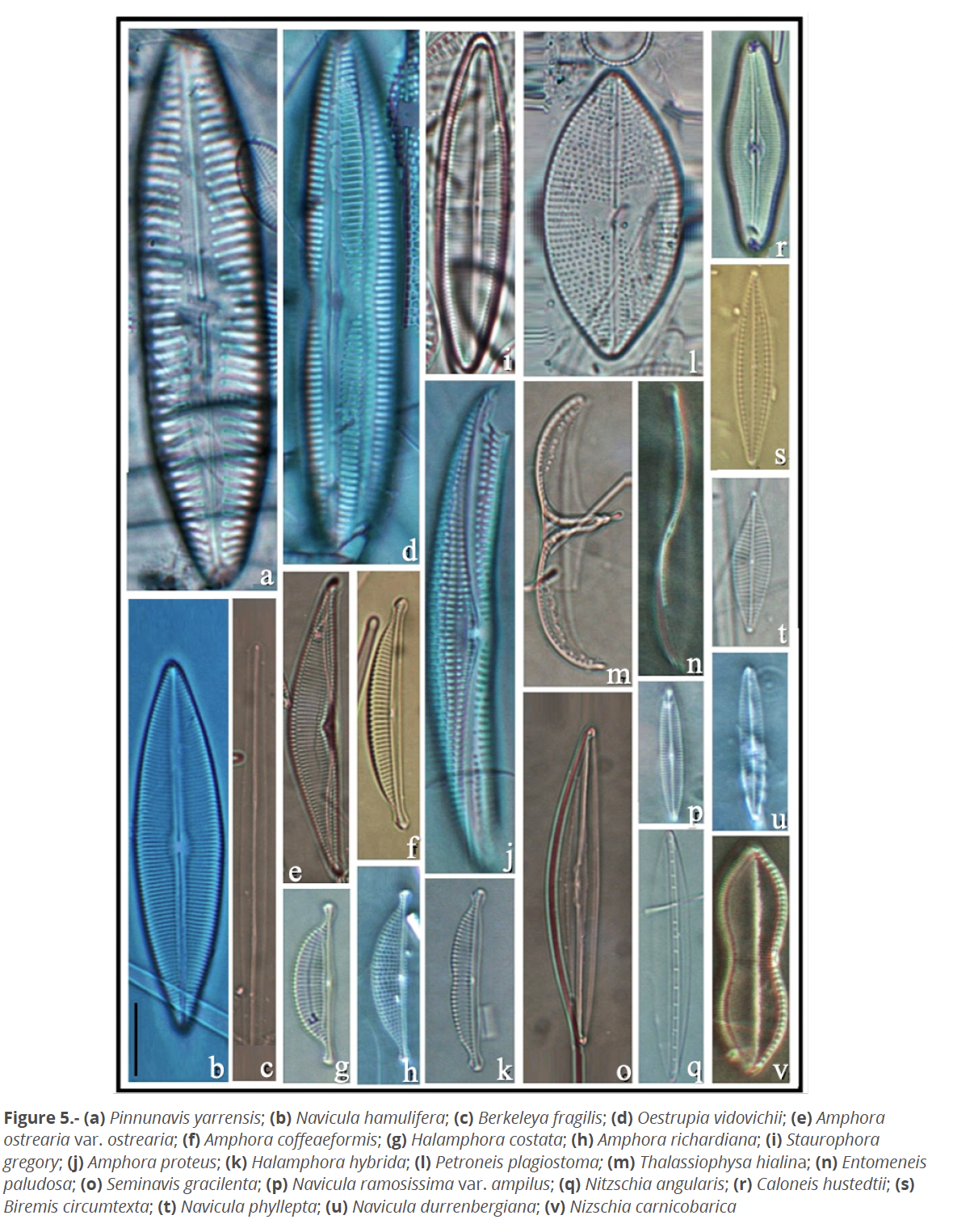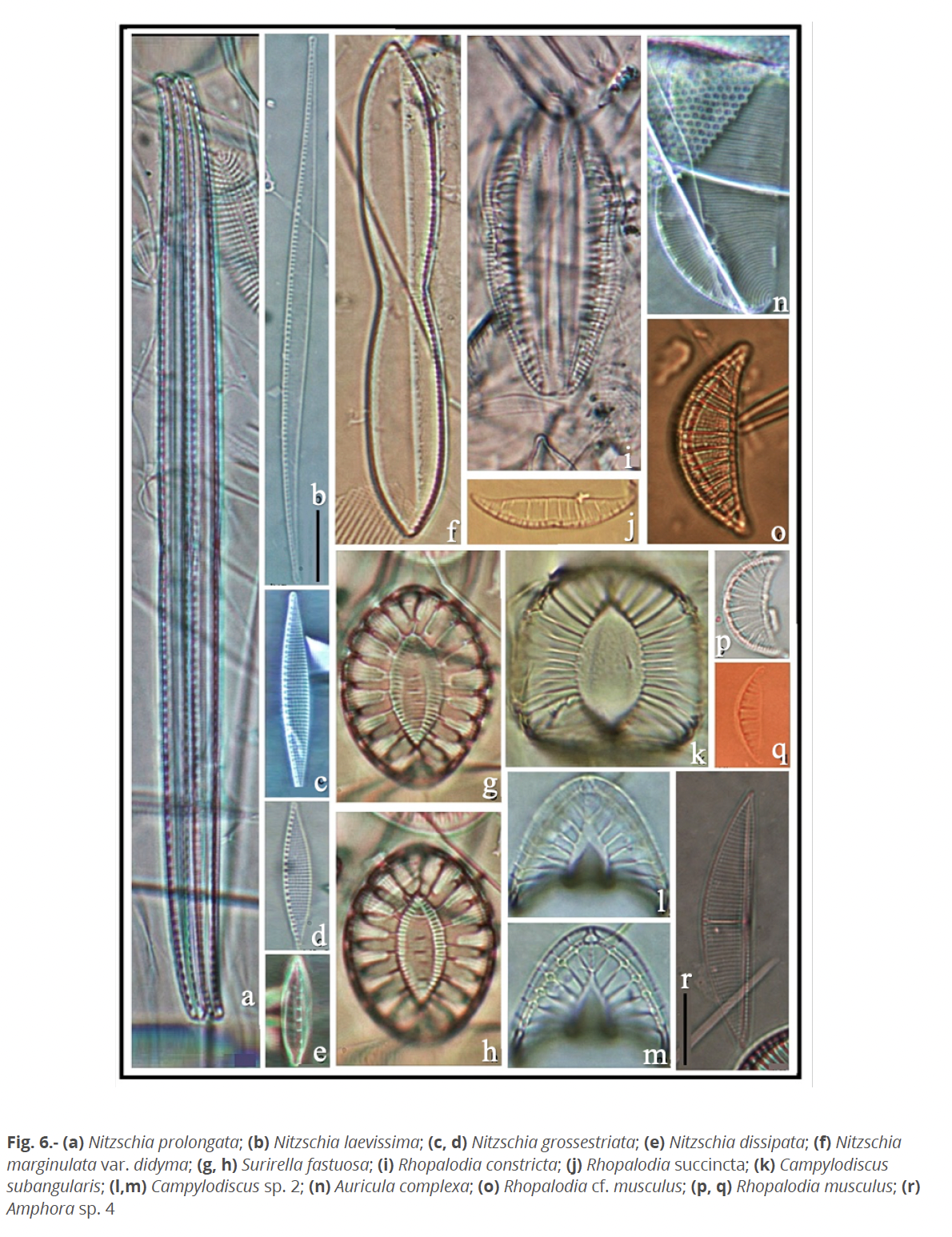Floristics of epiphytic diatoms on Thalassia testudinum from the southern Gulf of Mexico
Florística de diatomeas epífitas de Thalassia testudinum del sur del golfo de México
Daniela López-Mejía1, David Alfaro Siqueiros-Beltrones2*, Francisco Omar López-Fuerte3 & Francisco Gutiérrez-Mendieta1
1 Universidad Autónoma Metropolitana – Iztapalapa, Laboratorio de ecosistemas costeros.
Av. San Rafael Atlixco 186, Leyes de Reforma 1ra. Secc. 09340 Ciudad de México, CDMX.
2 Instituto Politécnico Nacional, Centro Interdisciplinario de Ciencias Marinas, Dpto. Plancton y Ecología Marina.
Av. Instituto Politécnico Nacional S/N, Col. Playa Palo de Santa Rita, La Paz, BCS. CP 23096.
3 Departamento Académico de Ciencias Marinas y Costeras,
Universidad Autónoma de Baja California Sur, Km 5.5, Carretera al Sur, 23091 La Paz, Baja California Sur, México.
Corresponding author: dsiquei@gmail.com
D. López-Mejia, D.A. Siqueiros Beltrones, F.O. López-Fuerte & F. Gutiérrez-Mendieta. 2021. Floristics of epiphytic diatoms on Thalassia testudinum form the southern Gulf of Mexico. Cymbella 7 (1): 18-35. http://cymbella.mx
Abstract
Benthic diatoms are fast colonizers of live substrata, covering large surfaces of their hosts. Few studies exist on floristics of the epiphytic diatoms for the coasts of Mexico, and most of them deal with epiphytic diatoms that live on macroalgae or mangrove roots, while seagrasses which also provide an excellent substrate for diatoms are even scarcer. Our aim was to describe the species composition of epiphytic diatoms growing on blades of Thalassia testudinum from the southern Gulf of Mexico. To do this, three bundles of blades of T. testudinum were collected in each of 23 sampling sites off the coast of Campeche, Mexico. Epiphytic diatoms were scrapped off from the blades and then were oxidized to clean the diatom frustules, which were then mounted on permanent slides with Pleurax for taxonomic identification using light microscopy with plan-apochromatic optics. Overall, 238 taxa from 66 genera were identified, out of which 25 are new records for the Gulf of Mexico and 52 are new records for the Mexican coasts. The genus Mastogloia was the best represented with 51 taxa. This taxocoenosis surpasses the species richness recorded for other seagrass systems and is among the richest for Mexican littorals.
Key words: Campeche, epiphytic diatoms, seagrasses, taxocoenosisResumen
Las diatomeas bentónicas colonizan rápidamente sustratos vivos, llegando a cubrir gran parte de la superficie disponible de su hospedero. Los pocos estudios sobre florística de diatomeas epifitas para las costas de México tratan principalmente sobre diatomeas epifitas de macroalgas y raíces de mangles, mientras que, sobre pastos marinos, los cuales ofrecen un excelente sustrato para diatomeas, son aún más escasos. Nuestro objetivo fue describir la composición de especies de diatomeas epifitas que proliferan sobre hojas de Thalassia testudinum del sur del golfo de México. Para ello, se hicieron muestreos en 23 estaciones en la costa de Campeche, México, recolectando tres haces de T. testudinum en cada una. Las hojas de cada haz se rasparon para la obtención de las diatomeas y el material obtenido se oxidó para limpiar las frústulas y facilitar su identificación. Se montaron en preparaciones permanentes con Pleurax y se revisaron bajo un microscopio compuesto con óptica planapocromática. Se identificaron 238 taxones pertenecientes a 66 géneros de los cuales Mastogloia (51 taxones) presentó la mayor riqueza. De los taxones identificados, 25 son nuevos registros para el golfo de México, y 52 son nuevos registros para las costas de México. La taxocenosis descrita supera a las registradas para otros ambientes de pastos marinos y representa una de las más ricas para litorales mexicanos.
Palabras clave: Campeche, diatomeas epifitas, pastos marinos, taxocenosis
Introduction.
Benthic diatoms play an important role within the microbial communities that characterize certain habitats (Siqueiros-Beltrones 2002). They are fast colonizers of both non-living surfaces (MacLulich 1986) and live substrata (Sieburth & Thomas 1973) where they may cover a great part of the available surfaces of their hosts, such as macroalgae (Siqueiros-Beltrones et al. 2004; Siqueiros Beltrones et al. 2016) or seagrasses (Siqueiros-Beltrones & Ibarra-Obando 1985).
Although studies on epiphytic diatoms may be considered lacking worldwide, mainly because of the enormous scientific research potential around them, sufficient theoretical basis exists to address and investigate diverse roles of epiphytic diatoms, weather on their taxonomy including floristics, their ecology, biogeography, or eco-physiological interactions with their hosts. However, there is still much to do concerning floristics alone (Siqueiros-Beltrones & Martínez-Hernández 2017).
For the Mexican coasts little research exist and has been done on diatom floristics, most related to epiphytic diatoms from macroalgal hosts. Evidence from these studies suggests that macroalgae provide more than just attaching surfaces for diatoms (Hernández-Almeida & Siqueiros-Beltrones 2008, 2012; Siqueiros-Beltrones & Hernández-Almeida 2006). On the other hand, pioneer research that can be traced to the first floristic study on diatoms found living on blades of sea grass (Zostera marina L.) in NW Mexico shows that seagrasses also provide vast surfaces for colonization by as many as 215 species of diatoms, either free living or colonial forms (Siqueiros-Beltrones & Ibarra-Obando 1985). Elsewhere, in Caribbean waters (Grand Cayman) Corlett and Jones (2007) recorded 61 diatom species on T. testudinum blades, while López-Fuerte et al. (2013) identified 107 taxa and infra-species from Laguna de Yalahau for the Mexican Caribbean. Likewise, along the Atlantic coasts (Florida Bay) Reyes-Vazquez (1970) described 42 species of epiphytic diatoms on T. testudinum, while Sullivan (1979) recorded 32 species. More recently, Frankovich et al. (2006) listed up to 255 diatom taxa (species and infra-species), the highest species richness of epiphytic diatoms ever observed on T. testudinum blades exposing the floristic potential of epiphytic diatoms on this substrate. In contrast, besides the Mastogloia species list published by Siqueiros-Beltrones et al. (2020) no other formal studies on epiphytic diatoms of seagrasses have been carried out hitherto for the Mexican Atlantic, where turtle-grass Thalassia testudinum K. D. Koenig is widely distributed at low depths (Spalding et al. 2003).
The extension and resilience of T. testudinum beds in the southern Gulf of Mexico (GM) offers an excellent opportunity to study the epiphytic diatoms that use them as hosts, also providing a floristic frame for the Mastogloia species that characterize this particular ecosystem (Siqueiros-Beltrones et al. 2020). Thus, our objective was to describe the species composition of epiphytic diatom living on T. testudinum blades from the southern GM off the coast of Campeche, Mexico. Because our approach was mainly floristics, we proposed the hypothesis that the species richness would be higher than in the above studies and would include taxa that are new additions to the current floristic list for Mexican littorals (López-Fuerte & Siqueiros-Beltrones 2016). We must consider that references such as presence/absence of taxa are used to determine biogeographical distributions based on their relations with various environmental factors. In this way the effort dedicated to floristics may help to trim such interpretations down to a more precise dimension. Albeit relative abundances were estimated also to gain a preview of the more or less conspicuous taxa for later ecological and distribution analyses. And as it turned out, a previous report of this study widened the expectations on any unusual characteristic of the epiphytic diatom taxocoenosis, exemplified by the many recorded species of Mastogloia (Siqueiros-Beltrones et al. 2020).
Study area.
The study area is, located within the southern GM and comprises the north coast of the State of Campeche, between the municipalities of Champotón and Calkiní (19° 19’ 43.90’’ and 20° 20’ 23.30’’ N, 90° 47’48. 90’’ and 90° 129’ 43.30’’ W). There, three sites were surveyed: 1) Champotón, located in front of the Champotón river, considered the most important estuary in the state (Villalobos-Zapata & Mendoza-Vega 2010); 2) Petenes, located in the northernmost coast of the state within the Biosphere Reserve Los Petenes (DOF, 24, May 1999) that covers an extension of 282,857 ha; and 3) Costa, located on the coast of the city of San Francisco de Campeche (Fig. 1).
Methods.
Sampling was carried out in 2013 on April 8 - 11 in Petenes, from April 29 - May 2 in Champotón, and from August 17 - 20 in Costa, in a total of 23 sampling sites: six in Champotón, seven in Costa, and 10 in Petenes. Sites were chosen according to the occurrence and extension of T. testudinum beds. In each site three bundles of the seagrass were collected and stored in 1 L plastic jars. At the laboratory all the blades from the bundles were scraped with a spatula to separate the epiphytic diatoms. The gathered material was oxidized in flasks to eliminate all organic matter using nitric acid and commercial alcohol (Siqueiros-Beltrones 2002). The cleaned diatom frustules were mounted on permanent slides using synthetic resin Pleurax (R.I. = 1.7).
The permanent mounts were observed under an Axioscope 40 Zeiss compound microscope with plan-apochromatic optics. Diatoms were identified on the basis of frustule morphology using classic references: Cleve-Euler (1952, 1953a, 1953b, 1955), Hustedt (1930,1959, 1966), Peragallo & Peragallo (1908), Schmidt (1874-1959); as well as more recent literature: Foged (1975,1978,1984), Krammer & Lange-Bertalot (1991), Lange-Bertalot & Krammer (1987), Lange-Bertalot et al. (1996), Lobban et al. (2012), Loir & Novarino (2013), López-Fuerte et al. (2010), López-Fuerte et al. (2013), Metzeltin and García-Rodrígez (2003), Moreno et al. (1996), Novelo et al. (2007), Siqueiros-Beltrones (2002), Siqueiros-Beltrones et al. (2004), Stidolph et al. (2012), Tomas (1997), Witkowski et al. (2000). Taxonomic nomenclature was updated using Guiry & Guiry (2020) and Round et al. (1990).
Quantitatively, taxa were classified according to their relative abundances (N=500) into rare (15<X≤1), frequent (100<X≤15), abundant (300<X≤100), and very abundant (>300). Similarity between the surveyed localities was measured using Jaccard presence/absence index. The resulting floristic list was contrasted with the recent available floristic lists both for the GM and the Mexican coasts overall (Krayesky et al. 2009; Licea et al. 2016; López-Fuerte & Siqueiros-Beltrones 2016; López-Fuerte et al. 2013; Siqueiros-Beltrones & Martínez-Hernández 2017). Images of representative taxa including several new records were captured using a CMOS Konus digital ocular lens microscope at 1000×.
Results.
A total of 238 epiphytic diatom taxa from 66 genera were identified living on the blades of T. testudinum from the northern coast of the State of Campeche (Table 1). The most diverse genus was Mastogloia with 51 species and varieties, with 11 taxa found in a single locality; following were Nitzschia (22taxa), Navicula (17), Amphora (13), Cocconeis (13) and Halamphora (12). Only two taxa on the list were not assigned to a taxon at species level, while 63 other potential species not included in the list remained unidentified, including 25 Mastogloia.
Overall, 19 taxa were not accounted for during the quantitative phase. Diatom species distribution was as follows: 100 taxa (42 %) were present in all three localities. In Champotón, 38 exclusive taxa were recorded. Whilst, in Costa and Petenes, 21 and 14 exclusive taxa were recorded, respectively. The diatom assemblages from Champotón yielded the highest species richness with 176 taxa and 54 genera; there, the most diverse genera were Mastogloia (43), Nitzschia (18) and Navicula (15). In Costa 141 taxa and 41 genera were found: 39 Mastogloia, 15 Nitzschia, 9 Navicula, Cocconeis and Halamphora taxa. In Petenes 136 species were recorded; there, Mastogloia comprised 34 species, Nitzschia 10, Cocconeis 10, and Amphora 4. On the basis of their quantitative classification diatom taxa were distributed in a similar way among the three localities, depicting a typical benthic diatom assemblage with few abundant and very abundant taxa, and many rare and frequent taxa (Table 2).
According to the Jaccard similarity index (presence/absence of taxa), two groups were formed separating the Costa from the Petenes and Champotón assemblages (Figure 2).
New records. Out of the above taxonomic list, 52 taxa are new records for the Mexican coasts and 25 are new records for the GM (Table 2); several are shown in figures 3-6. Three of these taxa were very abundant, particularly Cocconeis lineata, with the higher overall abundance (10.78 %) and Seminavis obtosiuscula (2.19 %); these two are new for the GM, and Mastogloia urveae (1.64 %), recently recorded for the Mexican coasts overall. For any of the three localities, two of the new records were abundant, three for Mexican coasts and three for the GM; 30 taxa were frequent, 21 for Mexican coasts and nine for the GM; and, 41 new records were rare taxa, 28 for Mexican waters and 13 for the GM. Thus, by locality, Champotón showed the higher number of new records (38 taxa), 16 for Mexico and 7 for GM. In Costa nine new records, six overall for Mexico and three for the GM. The Petenes locality had the lower number of new records (seven taxa), six for Mexico and one for GM.
Discussion.
Although the Champotón locality yielded the highest species richness and Petenes the lowest, these were grouped together, segregated from the Costa locality in the similarity analysis. The former two were surveyed during the dry season and the latter in the rainy season, suggesting that species composition of the diatom assemblages varied according to the corresponding seasonal environmental conditions. Besides the import of fresh-water taxa or seasonal exclusion of strict marine forms, the seasonal distribution of other coastal marine taxa requires investigation, along with further taxonomic issues.
It is but surprising that this report on the epiphytic diatoms of Thalassia testudinum is only the fourth formal floristic study on seagrasses (the third was derived from the same project, Siqueiros-Beltrones et al. 2020) that serve as hosts for diatoms in Mexican waters after Siqueiros-Beltrones and Ibarra-Obando (1985) for Zostera marina, a second one for T. testudinum (López-Fuerte et al. 2013). Although the floristic account in this study (238 taxa) is one of the richest for Mexican littorals, it is surpassed by the epipelic assemblages (325 taxa) observed in Bahía Magdalena, BCS, Mexico (López-Fuerte & Siqueiros-Beltrones 2006), and by the epiphytic diatom assemblages from multi-specific macroalgae hosts (271 taxa) surveyed by Hernández-Almeida & Siqueiros-Beltrones (2012).
Albeit, compared to similar studies, the species richness in this study surpasses the 215 taxa recorded for Zostera marina in NW Mexico (Siqueiros-Beltrones & Ibarra-Obando 1985), being very similar to the 232 epipelic diatom taxa recorded at Guerrero Negro lagoon, also in the NW region (Siqueiros-Beltrones et al. 2017). And, although it falls short from the 255 taxa recorded by Frankovich et al. (2006) in the Florida (USA) T. testudinum beds, more than 60 taxa remain unidentified for the Campeche samples. As it is, it more than doubles the 107 taxa recorded recently by López-Fuerte et al. (2013) for the same species host in the Caribbean.
Our ex professo qualitative outlook for diatom species living on T. testudinum blades was influential in supporting part of our hypothesis; the high species richness may well be a combination of this and the tropical habitat, which could be reflected on the numerous species observed of Mastogloia (Siqueiros-Beltrones et al. 2020), although only 51 identified to species level. This agrees with the taxonomic diversity of this genus (>80 taxa) recorded for the Caribbean by Loir and Novarino (2013) albeit in sediments. It would thus seem more related to a biogeographical factor than to substrate affinity, both for this genus and rest of the recorded taxa.
Similar comparisons to the above are now possible based on this floristic account of epiphytic diatoms of T. testudinum for the southern Gulf of Mexico. Besides the biogeographic implications, this taxonomic reference may aid in ecological studies, e.g., trophic relations with various species of grazers such as snails, sea-turtles, and manatees that forage on these seagrass beds. However, much formal taxonomic work is needed on the benthic diatoms of Mexican littorals in order to adequately complement the much-needed floristic studies. This is supported also by the high abundance of six new records.
Notwithstanding, both the species richness and the observed species composition of these epiphytic diatom assemblages may serve as reference in assessing environmental impact as to how undisturbed habitat conditions may reflect on the structure of these diatom assemblages.
Acknowledgements.
This study was supported by project “Indicadores del estado de las comunidades de pastos marinos en la zona costera del Golfo de México: Fase II”, (Margarita E. Gallegos Martinez). It is part of the Master in Biology thesis of D. López Mejía who received a scholarship from CONACYT at Universidad Autónoma Metropolitana – Iztapalapa. The second author (DASB) is fellow of Comisión de Operación y Fomento de Actividades Académicas (COFAA), and Estímulo al Desempeño de los Investigadores (EDI) IPN. We acknowledge the precise observations by three anonymous referees to a former manuscript.
References
Cleve-Euler, A. 1952. Die diatomeen Von Schweden und Finnland. Teil V. (Schluss.) Almqvist & Wiksells Boktryckeri Ab, Stockholm.
Cleve-Euler, A. 1953a. Die diatomeen Von Schweden und Finnland. Teil II. Arraphideae, Brachyraphideae. Almqvist & Wiksells Boktryckeri Ab, Stockholm.
Cleve-Euler, A. 1953b. Die diatomeen Von Schweden und Finnland. Teil III. Monoraphideae, Biraphideae 1. Almqvist & Wiksells Boktryckeri Ab, Stockholm.
Cleve-Euler, A. 1955. Die diatomeen Von Schweden und Finnland. Teil IV. Biraphideae 2. Almqvist & Wiksells Boktryckeri Ab, Stockholm.
Corlett, H. & B. Jones. 2007. Epiphyte communities on Thalassia testudinum from Grand Cayman, British West Indies: Their composition, structure, and contribution to lagoonal sediments. Sedimentary Geology 194: 245–262
Foged, N. 1975. Some littoral diatoms from the coast of Tanzania. Bibliotheca phycologica 16. J. Cramer, Vaduz.
Foged, N. 1978. Diatoms in eastern Australia. Bibliotheca phycological 41. J. Cramer, Vaduz.
Foged, N. 1984. Freshwater and littoral diatoms from Cuba. Bibliotheca diatomologica 5. J. Cramer, Vaduz.
Frankovich, T.A., E.E. Gaiser, J.C. Zieman & A.H. Wachnicka. 2006. Spatial and temporal distributions of epiphytic diatoms growing on Thalassia testudinum Banks ex König: relationships to water quality. Hydrobiologia 569: 259–271.
Guiry, M.D. & G.M. Guiry. 2020. AlgaeBase. World-wide electronic publication, National University of Ireland, Galway. http://www.algaebase.org; searched on 27 July 2021.
Hernández-Almeida, O.U. & D.A. Siqueiros-Beltrones. 2008. Variaciones en la Estructura de Asociaciones de Diatomeas Epifitas de Macroalgas en una Zona Subtropical. Hidrobiológica 18: 51–61.
Hernández-Almeida, O.U. & D.A. Siqueiros-Beltrones. 2012. Substrate-dependent differences between the structures of epiphytic and epilithic diatom assemblages off the southwestern coast of the Gulf of California. Botanica Marina 55: 149–159. DOI:10.1515/BOT.2011.103
Hustedt, F. 1930. Die Kieselalgen Deutschland, Österrreich und der Schweiz mit Berücksichtigung der übringen Länder Europas sowie der angrenzenden Meeresgebiete. In: L. Rabenhorst. Ed. Kryptogamen-Flora von Deutschland, Österreich und der Schweiz, VII Band, I Teil (pp. 348, 453, 506, 535) Koeltz Scientific Book, Leipzig
Hustedt, F. 1959. Die Kieselalgen Deutschland, Österrreich und der Schweiz mit Berücksichtigung der übringen Länder Europas sowie der angrenzenden Meeresgebiete. In: L. Rabenhorts. Ed. Kryptogamen-Flora von Deutschland, Österreich und der Schweiz, VII Band, II Teil. Koeltz Scientific Book, Leipzig.
Hustedt, F. 1966. Die Kieselalgen Deutschland, Österrreich und der Schweiz mit Berücksichtigung der übringen Länder Europas sowie der angrenzenden Meeresgebiete. In: L. Rabenhorst. Ed. Kryptogamen-Flora von Deutschland, Österreich und der Schweiz. VII Band, III Teil. Koeltz Scientific Book. Leipzig.
Krammer, K. & H. Lange-Bertalot. 1991. Bacillariophyceae Teil. 4, Achnanthaceae, Kritische Ergänzungen zu Navicula (Lineolatae) und Gomphonema. Gesamtliteraturverzeichnis Teil 1-4. In: A. Pascher, H. Ettl, J. Gerloff, H. Heynig and D. Mollenhauer. Eds. Süßwasserflora von Mitteleuropa. Gustav Fischer Verlag, Stuttgart.
Krayesky, D.M., E. Meave del Castillo, E. Zamudio, J.N. Norris & S. Fredericq. 2009. Diatoms (Bacillariophyta) of the Gulf of Mexico. In: D.L. Felder, D.K. Camp. Eds. Gulf of Mexico: Origin, Waters, and Biota. Volume 1, Biodiversity. Texas A & M University Press, Corpus Christi. Pp: 155-186.
Lange-Bertalot, H., K. Külbs, T. Lauser, M. Nörpel-Schempp, M. Willmann. 1996. Dokumentation und Revision der von Georg Krasske Beschriebenen Diatomeen-Taxa. Iconographia Diatomologica 3, Koeltz Scientific Books, Königstein.
Lange-Bertalot, H. & K. Krammer. 1987. Bacillariaceae, Epithemiaceae, Surirellaceae. Neue und wenig bekannte Taxa, neue Kombinationen und Synonyme sowie Bemerkungen und Er- gänzungen zu den Naviculaceae. Bibliotheca Diatomologica 15. J. Cramer, Berlin – Stuttgart.
Licea, S., J.L. Moreno-Ruíz, & R. Luna. 2016. Checklist of Diatoms (Bacillariophyceae) from the Southern Gulf of Mexico: Data-Base (1979-2010) and New Records. Journal of Biodiversity of Endangered Species 4. DOI: 10.4172/2332-2543.1000174
Lobban, C.S., R.W. Jordan, Y. Arai, A. Sasaki, E.C. Theriot, M. Ashworth, E.C. Ruck & C. Pennesi. 2012. Coral-reef diatoms (Bacillariophyta) from Guam: new records and preliminary checklist, with emphasis on epiphytic species from farmer-fish territories. Micronesica 43: 237–479.
Loir, M. & G. Novarino. 2013. Marine Mastogloia Thwaites ex W. Sm. and Stigmaphora Wallich species from the French Lesser Antilles. Diatom Monographs 16. Koeltz Scientific Books, Königstein.
López-Fuerte, F.O. & D.A. Siqueiros-Beltrones. 2006. Distribución y estructura de asociaciones de diatomeas en sedimentos de un sistema de manglar. Hidrobiológica 16: 23-33.
López-Fuerte, F.O. & D.A. Siqueiros-Beltrones. 2016. A checklist of marine benthic diatoms (Bacillariophyta) from Mexico. Phytotaxa 283: 201–258. doi:10.11646/phytotaxa.283.3.1
López-Fuerte, F.O., D.A. Siqueiros-Beltrones & O.U. Hernández-Almeida. 2013. Epiphytic diatoms of Thalassia testudinum in Yalahau lagoon, Quintana Roo, México. Marine Biodiversity Records 6. doi:10.1017/S1755267213000857
López-Fuerte, F.O., D.A. Siqueiros-Beltrones & J.N. Navarro. 2010. Benthic diatoms associated with mangrove environments in the Northwest region of México. Comisión Nacional para el Conocimiento y Uso de la Biodiversidad, Universidad Autónoma de Baja California Sur, Instituto Politécnico Nacional, Centro Interdisciplinario de Ciencias Marinas, La Paz.
MacLulich, J.H. 1986. Colonization of bare rock surfaces by microflora in a rocky intertidal habitat. Marine Ecolology Progress Series 32: 91–96.
Metzeltin, D. & F. García-Rodríguez. 2003. Las diatomeas uruguayas. Universidad de la República - Facultad de Ciencias, Montevideo.
Moreno, J.L., S. Licea & H. Santoyo. 1996. Diatomeas del Golfo de California. Universidad Autónoma de Baja California Sur, La Paz.
Novelo, E., R. Tavera & C. Ibarra. 2007. Bacillariophyceae from karstic wetlands in México Bibliotheca Diatomologica 54. J. Cramer, Stuttgart.
Peragallo, H. & M. Peragallo. 1908. Diatomées marines de France et des districts maritimes voisins. M.J. Tempere, Grez-sur-Loing.
Reyes-Vasquez, G. 1970. Studies on the diatom flora living on Thalassia testudinum König in Biscayne Bay, Florida. Bulletin of Marine Science 20: 105–134.
Round, F.E., R.M. Crawford & D.G. Mann. 1990. The Diatoms. Biology and morphology of the genera. Cambridge University Press, Cambridge.
Schmidt, A. 1874-1959. Atlas der Diatomaceen-Kunde, von A. Schmidt, continued by M. Schmidt, F. Fricke, H. Heiden, O. Muller, F. Hustedt. Reisland, Leipzig.
Sieburth, J.M. & C. Thomas. 1973. Fouling on eelgrass (Zostera marina). Journal of Phycology 9: 46-50.
Siqueiros-Beltrones, D.A. 2002. Diatomeas Bentónicas de la Península de Baja California, Diversidad y Potencial Ecológico. Instituto Politécnico Nacional, Universidad Autónoma de Baja California, La Paz.
Siqueiros Beltrones, D. A., U. Argumedo Hernández & C. Landa Cansigno. 2016. Uncommon species diversity values in epiphytic diatom assemblages of the kelp Eisenia arborea J.E. Areschoug. Hidrobiológica 26: 61-76
Siqueiros-Beltrones, D.A. & O.U. Hernández-Almeida. 2006. Florística de diatomeas epifitas en un manchón de macroalgas subtropicales. CICIMAR-Oceánides 21: 11–61.
Siqueiros-Beltrones, D.A. & Y.J. Martínez-Hernández. 2017. Prospective floristics of epiphytic diatoms on Rhodophyta from the southern Gulf of Mexico. CICIMAR-Oceánides 32: 35–49.
Siqueiros Beltrones, D.A., U. Argumedo Hernández & O.U. Hernández Almeida. 2017. High species diversity (H´) of benthic diatoms in a coastal lagoon located within a natural protected area. Hidrobiológica 27: 293-300.
Siqueiros-Beltrones, D.A. & S.E. Ibarra-Obando. 1985. Lista floristica de las diatomeas epifitas de Zostera marina en Bahía Falsa, San Quintín. Ciencias Marinas 11: 21–67.
Siqueiros-Beltrones, D., D. López-Mejía & F. Gutiérrez-Mendieta. 2020. High species richness of epiphytic Mastogloia Thwaites ex W. Sm. (Mastogloiales; Bacillariophyceae) on Thalassia testudinum K.D. Koenig the southern Gulf of México. Revista Mexicana de Biodiversidad 91: e912976 https://doi.org/10.22201/ib.20078706e.2020.91.2976
Siqueiros-Beltrones, D.A., G. Valenzuela-Romero, O.U. Hernández-Almeida, U. Argumedo-Hernández & F.O. López-Fuerte. 2004. Catálogo iconográfico de diatomeas de hábitats rocosos y su incidencia en la dieta de abulones (Haliotis spp.) jóvenes de Baja California Sur, México. CICIMAR-Oceánides 19: 29-03.
Spalding, M., M. Taylor, C. Ravilious, F. Short, E. Green. 2003. Global overview. The distribution and status of seagrasses, In: E.P. Green & F.T. Short. Eds. World atlas of seagrasses. UNEP- World Conservation Monitoring Centre, University of California Press, Berkeley, pp. 21-26.
Stidolph, S.R., F.A.S Sterrenburg, K.E.L. Smith, & A. Kraberg. 2012. Stuart R. Stidolph Diatom Atlas. U.S. Geological Survey Open-File Report 2012-1163.
Sullivan M.J. 1979. Epiphytic diatoms of three seagrass species in Mississippi Sound. Bulletin of Marine Science, 29: 459–464.
Tomas, C.R. 1997. Identifying marine phytoplankton. Academic Press, San Diego.
Villalobos-Zapata, G.J. & J. Mendoza-Vega. 2010. La biodiversidad en Campeche: Estudio de Estado. Comisión Nacional para el Conocimiento y Uso de la Biodiversidad (CONABIO), Gobierno del Estado de Campeche, Universidad Autónoma de Campeche, El Colegio de la Frontera Sur, México.
Witkowski, A., H. Lange-Bertalot, & D. Metzeltin. 2000. Diatom flora of marine coast I. Iconographia Diatomologica. Annotated Diatom Monographs 7. Gantner Verlag KG., Rugell.
Sometido: 3 de abril de 2021
Revisado: 24 de junio de 2021
Corregido: 28 de julio de 2021
Aceptado: 1 de agosto de 2021

